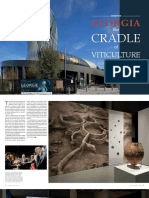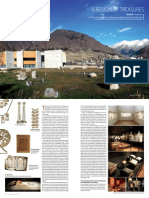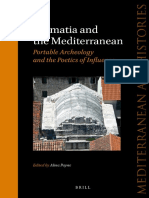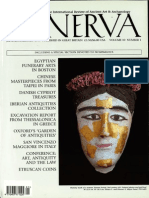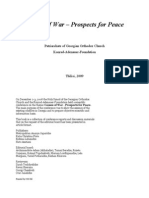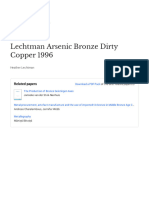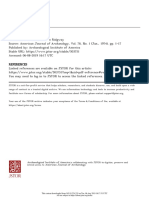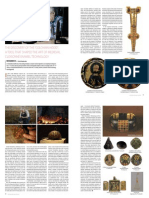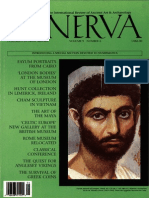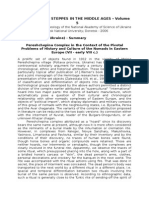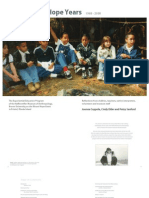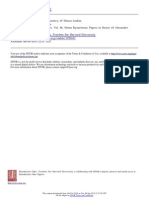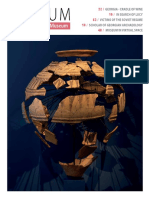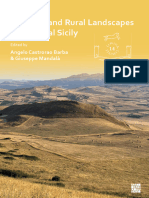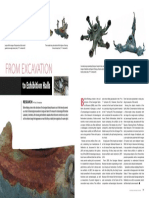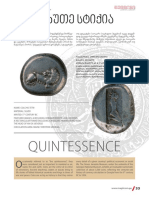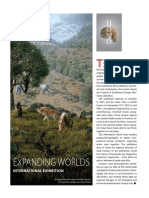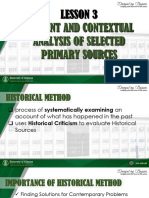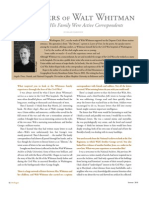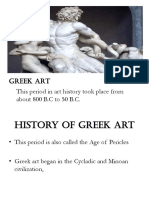Svaneti Museum
Svaneti Museum
Uploaded by
Georgian National MuseumCopyright:
Available Formats
Svaneti Museum
Svaneti Museum
Uploaded by
Georgian National MuseumCopyright
Available Formats
Share this document
Did you find this document useful?
Is this content inappropriate?
Copyright:
Available Formats
Svaneti Museum
Svaneti Museum
Uploaded by
Georgian National MuseumCopyright:
Available Formats
SVANETI MUSEUM
THE SVANETI MUSEUM OF HISTORY AND
ETHNOGRAPHY IS ONE OF THE CANDIDATES
FOR THE EUROPEAN MUSEUM OF THE YEAR
AWARD (EMYA) 2016!
SVANETI MUSEUM
saqarTvelos erovnuli muzeumis svaneTis
muzeumi evropis muzeumebis forumis mier
konkursis - ,,evropis wlis muzeumi 2016 kandidatad dasaxelda!
Svaneti Museum
42
A PUBLICATION OF TBILISI MARRIOTT HOTEL & COURTYARD BY MARRIOTT TBILISI
A PUBLICATION OF TBILISI MARRIOTT HOTEL & COURTYARD BY MARRIOTT TBILISI
43
SVANETI MUSEUM
SVANETI MUSEUM
If
we take a look at Georgias history, we will see
that because of its geographic location, this
country has acted as the natural crossroad
of different civilizations and that at the same time, it
has managed to preserve its cultural independence.
It is difficult to find a context anywhere else in the
world where nature and cultural heritage have been
preserved so well and have merged so organically, as
in Svaneti.
Svaneti has been a strategic gateway to the country
throughout the long and stormy history of Georgia. It
is associated with treasury keeping but Svaneti is
not only the loyal guard of Georgian treasures, it is an
organic part of a united Georgian culture, and despite
its geographic location it has played an active role in
global processes.
Pin, Second half of the
2nd millennium BC
Kala, Bronze,
Length 10.5 cm
44
A PUBLICATION OF TBILISI MARRIOTT HOTEL & COURTYARD BY MARRIOTT TBILISI
A PUBLICATION OF TBILISI MARRIOTT HOTEL & COURTYARD BY MARRIOTT TBILISI
45
SVANETI MUSEUM
SVANETI MUSEUM
The Forty Martyrs of Sebaste. 12th century. Wood, canvas, gesso, gold sheet, tempera. 68 x 52.5 cm
Enthroned Saviour. Artist: Thevdore Gvazavaisdze. 11th century. Wood, silver. 35 x 26 cm
In the 4th century, the Christianization of Georgia and the creation
of the Georgian alphabet have paved the way for an independent
Georgian culture, and the development of Georgian art during the
middle ages is closely connected to Christianity. The churches
and unique works of Christian art that one can find in Svaneti are
a valuable part of world heritage, and the majority of movable
artifacts of the sort are preserved at the Svaneti Museum, which
is part of the Georgian National Museum. The Svaneti Museum
is almost a hundred years old, and has started a new life since
2013, when a new building complying with contemporary
international standards and a new exhibition were inaugurated,
with new lighting and overall equipment. The Svaneti Museum is
46
visible from almost all spots in Mestia (the exact address is 7,
A. Ioseliani Street). The architect of this contemporary building
is Giga Kiknadze the structure blends in the landscape and
the historical surroundings naturally. A chronological voyage
back into history starts in the archaeological hall. The rich
archaeological material brought to light in Svaneti reflects the
uninterrupted history of this important centre of mountainous
Colchis from the 3rd-2nd millennia BC the Early Bronze Age
to the Middle Ages. The artifacts discovered in Svaneti confirm
the diversity and chronological continuity that attest to the
region being an integral part of a single system of
Georgian culture.
A PUBLICATION OF TBILISI MARRIOTT HOTEL & COURTYARD BY MARRIOTT TBILISI
The chronology of the Numismatics Halls collection starts in
the 5th century BC, with the Colchian Silver coin, and finishes
in the 20th century with foreign coins. The presence of local and
foreign coins demonstrate the historical importance of Svaneti
as a strategic region, one that was actively involved in universal
money circulation.
The Christian Art collection reveals that during the middle ages,
Georgian culture evolved in close relationship with the leading
spiritual centers of Byzantium and Eastern Christianity, and
was characterized by its originality. As for the last gallery, it is
dedicated to a rich ethnographic exhibition.
The renewed museum allows us to better display the
originality and inventive character of Georgian culture.
If we take a look at Georgian culture, we will see that its
development mainly happened concurrently with the historical,
cultural, and artistic changes that were at hand around the
world. The diachronic section of the museum presents the
importance of Georgian artifacts in the context of world
cultural heritage.
You will be able to relax and admire views of Mestia and its
towers from the museums public hall, media library, and caf,
as well as to connect with any other part of the world with Wi-Fi.
A PUBLICATION OF TBILISI MARRIOTT HOTEL & COURTYARD BY MARRIOTT TBILISI
47
SVANETI MUSEUM
The Adishi Four Gospels (897) constitute the earliest surviving manuscript, decorated in an artistic style characteristic of the
9th-10th centuries. The title page has an equal-armed cross (quadrifolium). The miniatures are presented all together before
the written text. Illuminations depict the Evangelists and the manuscript begins with Canon Tables and ciboria. It was written in
Shatberdi, commissioned by the Abbot of the Sophron Monastery and was bound by the Deacon Michael. The text represents a
different and separate edition of the Gospels which includes an additional document relating the 14th century history of Svaneti.
48
A PUBLICATION OF TBILISI MARRIOTT HOTEL & COURTYARD BY MARRIOTT TBILISI
You might also like
- Svaneti Museum CatalogueDocument1 pageSvaneti Museum CatalogueGeorgian National Museum100% (1)
- Georgia The Cradle of ViticultureDocument3 pagesGeorgia The Cradle of ViticultureGeorgian National MuseumNo ratings yet
- Georgia The Cradle of ViticultureDocument3 pagesGeorgia The Cradle of ViticultureGeorgian National MuseumNo ratings yet
- Bird & Hyslop 1985 - Preceramic Excavations - Huaca Prieta - Chicama Valley (AMNH)Document304 pagesBird & Hyslop 1985 - Preceramic Excavations - Huaca Prieta - Chicama Valley (AMNH)André Valencia Garcia100% (1)
- Seema Alavi-Muslim Cosmopolitanism in The Age of Empire-Harvard University Press (2015)Document505 pagesSeema Alavi-Muslim Cosmopolitanism in The Age of Empire-Harvard University Press (2015)Ja Bir PNo ratings yet
- A Region of TreasuresDocument2 pagesA Region of TreasuresGeorgian National Museum100% (1)
- Cooperation With Georgia's Regional MuseumsDocument4 pagesCooperation With Georgia's Regional MuseumsGeorgian National MuseumNo ratings yet
- Settlements, Culture and Population Dynamics in Balkan Prehistory - Abstracts of The Oral and Poster PresentationsDocument61 pagesSettlements, Culture and Population Dynamics in Balkan Prehistory - Abstracts of The Oral and Poster PresentationsHAEMUS - Center for scientific research and promotion of culture100% (1)
- ქართული ხელნაწერი წიგნიDocument47 pagesქართული ხელნაწერი წიგნიTornike Koroglishvili100% (3)
- Reserchers in IBERIA - COLCHOLOGYDocument345 pagesReserchers in IBERIA - COLCHOLOGYGeorgian National Museum100% (1)
- The Aesthetic Value of Textual Images: Pallava Script and Petroglyphic Images On Semi-Portable Stones From Bandung Museum, Indonesia (Western Java)Document18 pagesThe Aesthetic Value of Textual Images: Pallava Script and Petroglyphic Images On Semi-Portable Stones From Bandung Museum, Indonesia (Western Java)Digital DiggingNo ratings yet
- (Mediterranean Art Histories 1) Alina Payne - Dalmatia and The Mediterranean - Portable Archaeology and The Poetics of Influence (2014, Brill Academic Publishers) PDFDocument493 pages(Mediterranean Art Histories 1) Alina Payne - Dalmatia and The Mediterranean - Portable Archaeology and The Poetics of Influence (2014, Brill Academic Publishers) PDFAndrei DumitrescuNo ratings yet
- TbilisiDocument17 pagesTbilisiJosie Tomodachi100% (1)
- 1999 Vol 10 01Document76 pages1999 Vol 10 01poisonrouge2No ratings yet
- G. L. Kavtaradze. The Geopolitical Role of The Caucasus Mountains From The Historical PerspectiveDocument8 pagesG. L. Kavtaradze. The Geopolitical Role of The Caucasus Mountains From The Historical PerspectiveGiorgi Leon Kavtaraże100% (1)
- Giorgi L. Kavtaradze. An Attempt at Dating of The Starting Point of Kura-Araxes Culture On The Background of The "Uruk Cultural Phenomenon".Document30 pagesGiorgi L. Kavtaradze. An Attempt at Dating of The Starting Point of Kura-Araxes Culture On The Background of The "Uruk Cultural Phenomenon".Giorgi Leon KavtarażeNo ratings yet
- The Kykkotissa Virgin and Its Italian AppropriationDocument14 pagesThe Kykkotissa Virgin and Its Italian AppropriationdanaethomNo ratings yet
- Historical Dictionary of GeorgiaDocument775 pagesHistorical Dictionary of GeorgiatuncayergunakademiNo ratings yet
- On The Social Status of Some Gold Finds Dated To The 4th-7th Centuries From Todays Bulgarian LandsDocument33 pagesOn The Social Status of Some Gold Finds Dated To The 4th-7th Centuries From Todays Bulgarian LandsLunamorena86No ratings yet
- MziaDocument1 pageMziaGeorgian National MuseumNo ratings yet
- DROGOU - Hellenistic Pottery PDFDocument12 pagesDROGOU - Hellenistic Pottery PDFAgustín SaadeNo ratings yet
- Finding The Paeonians - Candace RichardsDocument2 pagesFinding The Paeonians - Candace RichardsSonjce Marceva100% (1)
- Geo-Tourism National GeographicDocument30 pagesGeo-Tourism National GeographicArvind EkkaNo ratings yet
- 2014 Contexts - Annual Report of The Haffenreffer Museum of AnthropologyDocument24 pages2014 Contexts - Annual Report of The Haffenreffer Museum of AnthropologyHaffenreffer Museum of AnthropologyNo ratings yet
- N. Y.) Metropolitan Museum of Art (New York, Katharine Reynolds Brown - Migration Art, A.D. 300-800-Metropolitan Museum of Art (1995)Document58 pagesN. Y.) Metropolitan Museum of Art (New York, Katharine Reynolds Brown - Migration Art, A.D. 300-800-Metropolitan Museum of Art (1995)kirstenNo ratings yet
- Dimitri Ermakov - Photographer and CollectorDocument3 pagesDimitri Ermakov - Photographer and CollectorGeorgian National MuseumNo ratings yet
- Biodeterioration of Mural Paintings in T PDFDocument411 pagesBiodeterioration of Mural Paintings in T PDFArq FranciscoRNo ratings yet
- Lechtman Arsenic Bronze Dirty Copper 1996-With-Cover-Page-V2Document40 pagesLechtman Arsenic Bronze Dirty Copper 1996-With-Cover-Page-V2Julio C. Sierra PalominoNo ratings yet
- New Age The Life of Mothers and Babies IDocument25 pagesNew Age The Life of Mothers and Babies IpestilenceNo ratings yet
- Tell Communities and Wetlands in Neolithic Pelagonia, Republic of Macedonia - Goce NaumovDocument16 pagesTell Communities and Wetlands in Neolithic Pelagonia, Republic of Macedonia - Goce NaumovSonjce Marceva100% (3)
- Bekic, Royal - The Croatia Coastal Survey 2012-2014 Field SeasonsDocument16 pagesBekic, Royal - The Croatia Coastal Survey 2012-2014 Field SeasonsutvrdaNo ratings yet
- A Story of Five AmazonsDocument22 pagesA Story of Five Amazonsjtg.jorgeNo ratings yet
- SplitDocument35 pagesSplit15luckyNo ratings yet
- Archaeological Museums of PakistanDocument16 pagesArchaeological Museums of PakistanAsim LaghariNo ratings yet
- The Discovery of The "Colchian Hood", A Tool That Shaped The Art of Medieval Cloisonné Enamel TechnologyDocument2 pagesThe Discovery of The "Colchian Hood", A Tool That Shaped The Art of Medieval Cloisonné Enamel TechnologyGeorgian National Museum100% (1)
- Art of The Sasanian EmpireDocument10 pagesArt of The Sasanian EmpireSepide HakhamaneshiNo ratings yet
- 1998 Vol 9 06Document76 pages1998 Vol 9 06poisonrouge2No ratings yet
- GCI Ancientmetals1Document96 pagesGCI Ancientmetals1Adriana Bernal100% (1)
- 1457 - v2 Gold Jewellery in Ptolemaic, Roman and Byzantine EgyptDocument281 pages1457 - v2 Gold Jewellery in Ptolemaic, Roman and Byzantine Egyptjsmithy456No ratings yet
- Komar Peresc, KjhkjhepinaDocument6 pagesKomar Peresc, KjhkjhepinaClarissaAlessandraGambuzzaNo ratings yet
- Intangible Heritage of The City Musealisation, Preservation, Education PDFDocument164 pagesIntangible Heritage of The City Musealisation, Preservation, Education PDFAndrzej Iwo Szoka100% (1)
- 1996 Vol 7 04Document68 pages1996 Vol 7 04poisonrouge2No ratings yet
- A Study of The Chemical Composition of Roman Silver Coinage, A.D. 196-197Document21 pagesA Study of The Chemical Composition of Roman Silver Coinage, A.D. 196-197Eesha Sen ChoudhuryNo ratings yet
- The Mount Hope Years: Joanna Coppola, Cindy Elder and Patsy SanfordDocument61 pagesThe Mount Hope Years: Joanna Coppola, Cindy Elder and Patsy SanfordHaffenreffer Museum of Anthropology100% (2)
- Vroom Postmedieval CeramicsDocument24 pagesVroom Postmedieval Ceramicslatinist1No ratings yet
- The First Century of The Monastery of Hosios LoukasDocument12 pagesThe First Century of The Monastery of Hosios LoukasMelkor Draco100% (1)
- Hellenistic Freestanding Sculpture From The Athenian Agora, Part 1: AphroditeDocument77 pagesHellenistic Freestanding Sculpture From The Athenian Agora, Part 1: Aphrodite78901419No ratings yet
- Gold in The CaucasusDocument38 pagesGold in The CaucasusTamta ChanturiaNo ratings yet
- Middle Helladic and Early Mycenaean Mortuary Customs in The Southern and Western Peloponnese ADocument276 pagesMiddle Helladic and Early Mycenaean Mortuary Customs in The Southern and Western Peloponnese AΑριστομένης ο ΜεσσήνιοςNo ratings yet
- Baram and Carroll - Historical Archaeology of The Ottoman Empire, ADocument277 pagesBaram and Carroll - Historical Archaeology of The Ottoman Empire, ALejla Becar100% (1)
- Journal "Museum"Document37 pagesJournal "Museum"Georgian National MuseumNo ratings yet
- Bartłomiej Szymon Szmoniewski - Byzantium and The Slavs in The Light of Goldsmiths' ProductionDocument12 pagesBartłomiej Szymon Szmoniewski - Byzantium and The Slavs in The Light of Goldsmiths' ProductionGermanik100% (1)
- Among Wetlands and Lakes: The Network of Neolithic Communities in Pelagonia and Lake Ohrid, Republic of Macedonia - Goce NaumovDocument14 pagesAmong Wetlands and Lakes: The Network of Neolithic Communities in Pelagonia and Lake Ohrid, Republic of Macedonia - Goce NaumovSonjce Marceva100% (1)
- Three Centuries of Late Roman PotteryDocument29 pagesThree Centuries of Late Roman PotteryBiljanaLučić100% (1)
- Cyril Mango, Ernest J. W. Hawkins. The Mosaics of St. Sophia at Istanbul. The Church Fathers in The North TympanumDocument83 pagesCyril Mango, Ernest J. W. Hawkins. The Mosaics of St. Sophia at Istanbul. The Church Fathers in The North TympanumlucekeramovNo ratings yet
- Suburbia and Rural Landscapes in Medieval SicilyDocument272 pagesSuburbia and Rural Landscapes in Medieval SicilyVratislav Zervan100% (1)
- Metcalf 1962Document26 pagesMetcalf 1962Isabella BaldiniNo ratings yet
- Journal "Museum"Document41 pagesJournal "Museum"Georgian National Museum100% (1)
- The Lost World of Old Europe CatalogueDocument129 pagesThe Lost World of Old Europe CatalogueivansuvNo ratings yet
- Muzeele Din Moldova....Document7 pagesMuzeele Din Moldova....Cristina SadoveiNo ratings yet
- Museum Entrance: MuseumsDocument14 pagesMuseum Entrance: MuseumsVasix ZoltanNo ratings yet
- Bosnian Tombstone / Stecak Tombstones of RadimljaDocument8 pagesBosnian Tombstone / Stecak Tombstones of Radimljaapi-27049944No ratings yet
- From Excavation To Exhibition HallsDocument1 pageFrom Excavation To Exhibition HallsGeorgian National MuseumNo ratings yet
- The Museum in Virtual SpaceDocument1 pageThe Museum in Virtual SpaceGeorgian National MuseumNo ratings yet
- ShalikoDocument4 pagesShalikoGeorgian National MuseumNo ratings yet
- Red Terror and Georgian ArtistsDocument5 pagesRed Terror and Georgian ArtistsGeorgian National MuseumNo ratings yet
- Sighnaghi MuseumDocument1 pageSighnaghi MuseumGeorgian National MuseumNo ratings yet
- Georgia A History of WineDocument2 pagesGeorgia A History of WineGeorgian National MuseumNo ratings yet
- MziaDocument1 pageMziaGeorgian National MuseumNo ratings yet
- Avant-Garde Art 1900-1937Document3 pagesAvant-Garde Art 1900-1937Georgian National MuseumNo ratings yet
- Boris KuftinDocument2 pagesBoris KuftinGeorgian National MuseumNo ratings yet
- A Distinguished Warrior's Burial From DmanisiDocument2 pagesA Distinguished Warrior's Burial From DmanisiGeorgian National MuseumNo ratings yet
- The Georgian Stone Age - A Major New ExhibitionDocument16 pagesThe Georgian Stone Age - A Major New ExhibitionGeorgian National MuseumNo ratings yet
- Torso of A YouthDocument2 pagesTorso of A YouthGeorgian National MuseumNo ratings yet
- Journal "Museum"Document37 pagesJournal "Museum"Georgian National MuseumNo ratings yet
- მეხუთე სტიქიაDocument10 pagesმეხუთე სტიქიაGeorgian National MuseumNo ratings yet
- Expanding WorldsDocument1 pageExpanding WorldsGeorgian National MuseumNo ratings yet
- Pirosmanashvili's Arsenal Hill at NightDocument2 pagesPirosmanashvili's Arsenal Hill at NightGeorgian National MuseumNo ratings yet
- Georgian Embroidery and Textiles CollectionDocument2 pagesGeorgian Embroidery and Textiles CollectionGeorgian National MuseumNo ratings yet
- Jewish Cultural HeritageDocument4 pagesJewish Cultural HeritageGeorgian National MuseumNo ratings yet
- Georgian National DressDocument4 pagesGeorgian National DressGeorgian National Museum100% (1)
- Music of ChinaDocument43 pagesMusic of ChinaJcee EsurenaNo ratings yet
- ManilaDocument35 pagesManilaEdgar TrinetNo ratings yet
- Science and Technology Studies - Wikipedia PDFDocument89 pagesScience and Technology Studies - Wikipedia PDFJoseph Neil Rabe CalunsagNo ratings yet
- Sources and Discourses in HistoriographyDocument102 pagesSources and Discourses in HistoriographyJohn Robert SorianoNo ratings yet
- Vipin HistoryDocument13 pagesVipin HistoryAashana AgarwalNo ratings yet
- Controversy 1st MassDocument11 pagesControversy 1st MassRYAN JEREZNo ratings yet
- The Best Jokes - 500 Funniest Jo - Harris Billigon PDFDocument479 pagesThe Best Jokes - 500 Funniest Jo - Harris Billigon PDFSimon James Shurety0% (1)
- LESSON 3 - HISTORICAL METHOD - (Importance Content vs. Context and The Author's Perspective) (20240306051602)Document11 pagesLESSON 3 - HISTORICAL METHOD - (Importance Content vs. Context and The Author's Perspective) (20240306051602)Antonette LaurioNo ratings yet
- Ancient HistoryDocument60 pagesAncient Historyn.ploegmanNo ratings yet
- English 10 Q2 Week 1Document10 pagesEnglish 10 Q2 Week 1ElleNo ratings yet
- Introduction To PHilippines HistoryDocument9 pagesIntroduction To PHilippines HistoryJP AbandoNo ratings yet
- Letters of Walt Whitman - Prologue - Summer 2010Document2 pagesLetters of Walt Whitman - Prologue - Summer 2010Prologue MagazineNo ratings yet
- MODULE 1 Introduction To HistoryDocument5 pagesMODULE 1 Introduction To HistoryLORD EILEEN LAGRISOLANo ratings yet
- The Danish History, Books I-IX by Saxo, GrammaticusDocument214 pagesThe Danish History, Books I-IX by Saxo, GrammaticusGutenberg.orgNo ratings yet
- History of Classical PhilologyDocument520 pagesHistory of Classical Philologypetitepik100% (1)
- Boston University African Studies Center The International Journal of African Historical StudiesDocument6 pagesBoston University African Studies Center The International Journal of African Historical StudiesOswald MtokaleNo ratings yet
- Paintings of AmorsoloDocument16 pagesPaintings of AmorsoloRoland PacioNo ratings yet
- Hayden White, HistoriophotyDocument8 pagesHayden White, Historiophotybeh20045965No ratings yet
- Greek Art This Period in Art History Took Place From About 800 B.C To 50 B.CDocument23 pagesGreek Art This Period in Art History Took Place From About 800 B.C To 50 B.CBryan ManlapigNo ratings yet
- Early Development of AccountingDocument4 pagesEarly Development of AccountingSakshiNo ratings yet
- Philippine Literature and Its Historical BackroundDocument8 pagesPhilippine Literature and Its Historical BackroundJamie AustriaNo ratings yet
- Pre Modern Kerala SocietyDocument4 pagesPre Modern Kerala SocietyamlaNo ratings yet
- IT S LIT E21 Drs Keisha Blain and Ibram X Kendi LDocument8 pagesIT S LIT E21 Drs Keisha Blain and Ibram X Kendi LGizmodo EditNo ratings yet
- 20x30 Title BlockDocument1 page20x30 Title BlockKamera LitratoNo ratings yet
- Aafreen Final Project6Document62 pagesAafreen Final Project6vaibhavNo ratings yet
- BA History - 16 - 11 - 17Document14 pagesBA History - 16 - 11 - 17SagarNo ratings yet
- (Impact of Empire) Olivier Hekster, Sebastian Schmidt-Hofner, Christian Witschel, Olivier Hekster, Sebastian Schmidt-Hofner, Christian Witschel-Ritual Dynamics and Religious Change in The Roman EmpireDocument393 pages(Impact of Empire) Olivier Hekster, Sebastian Schmidt-Hofner, Christian Witschel, Olivier Hekster, Sebastian Schmidt-Hofner, Christian Witschel-Ritual Dynamics and Religious Change in The Roman Empiresphmem100% (2)
- Seven World WondersDocument31 pagesSeven World WondersBookyNo ratings yet

